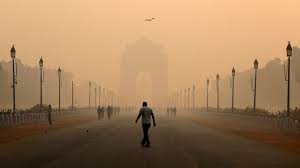
Source of Image: India Today
The Lancet Planetary Health report has highlighted a critical health crisis linked to high levels of PM 2.5 pollutants in India’s major urban centres. This study underscores the urgent need for improved air quality standards and effective pollution control measures in the country.
The Scope of the Study
An Indian-led research team conducted an extensive analysis of cancer-causing microparticles known as PM 2.5 pollutants across ten major Indian cities: Ahmedabad, Bengaluru, Chennai, Delhi, Hyderabad, Kolkata, Mumbai, Pune, Shimla, and Varanasi. These particles are small enough to penetrate deep into the lungs and enter the bloodstream, causing a range of serious health issues.
The Grim Statistics
The findings are alarming. Delhi, India‘s capital, suffers from some of the worst air pollution globally, leading to severe health repercussions for its residents. The study attributed approximately 12,000 annual deaths, or 11.5% of total deaths, in Delhi to short-term PM 2.5 exposure. Varanasi followed closely with 10.2% of deaths linked to air pollution.
Across the ten surveyed cities, the study found that short-term PM 2.5 exposure accounts for an average of 33,000 deaths annually. In Kolkata, the percentage of deaths attributable to PM 2.5 exposure is slightly above 7.2%, while even cities with comparatively lower pollution levels, like Shimla, are not exempt from risk. In Shimla, 3.7% of annual deaths, equating to 59 deaths, were linked to short-term PM 2.5 exposure, exceeding World Health Organization (WHO) guidelines.
Long-Term Impact
From 2008 to 2019, more than 33,000 deaths were attributed to PM 2.5 exposure above the WHO’s recommended limit of 15 micrograms per cubic meter. This represents 7.2% of the recorded deaths in these cities during that period. The findings highlight the inadequacy of India’s current air quality standards, which permit up to 60 micrograms of PM 2.5 per cubic meter—four times higher than the WHO’s guidelines.
Calls for Stricter Standards
Dr. Poornima Prabhakaran, Director of the Centre for Health Analytics Research and Trends (CHART) at Ashoka University’s Trivedi School of Biosciences, emphasised the significance of the study’s findings. She noted that even at lower levels of air pollution, the risks of mortality remain significant, underscoring the urgent need to rethink current air quality management strategies. Dr. Prabhakaran stressed the importance of shifting focus from regional to local sources of pollution to effectively safeguard public health.
Study co-author Joel Schwartz from Harvard University echoed this sentiment, stating that lowering and enforcing stricter limits on PM 2.5 could save tens of thousands of lives annually. “Methods for controlling pollution exist and are used elsewhere. They urgently need to be applied in India,” he said.
Global Perspective
The World Health Organization has highlighted that almost everyone on Earth breathes air that exceeds the recommended levels of pollution. This exposure is linked to severe health conditions, including strokes, heart disease, lung cancer, and other respiratory diseases.
Source of Image: Times Now
Conclusion
The study’s findings present a clear and urgent call to action. India’s air quality standards need to be toughened, and effective pollution control measures must be implemented without delay. Addressing air pollution is not only a matter of public health but also of social and economic importance, as healthier populations are more productive and incur lower healthcare costs.
1. Recommendations Strengthen Air Quality Standards:
Align India’s air quality standards with WHO guidelines to ensure safer air for all citizens.
2. Implement Localized Pollution Control Measures:
Focus on identifying and mitigating local sources of pollution to achieve significant improvements in air quality.
3. Raise Public Awareness:
Educate the public about the health risks associated with air pollution and the importance of adhering to air quality standards.
4. Enhance Monitoring and Reporting:
Improve air quality monitoring systems and ensure transparent reporting to enable informed decision-making.
By taking these steps, India can make substantial progress in protecting the health of its citizens and setting a precedent for other nations facing similar challenges.